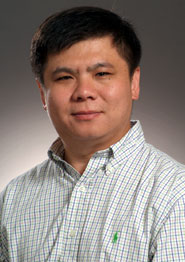- By Research Area
- By University
Directory
Faculty
Directory Details
[Return to Previous Listing]
Peng Jiang
Assistant Professor, Chemical Engineering, University of Florida
Phone: (352) 392-2189
319 CHE
http://www.che.ufl.edu/faculty/jiang/index.html
Education:
Ph.D., 2001, Rice University
Research Interests:
Our group develops new chemical, physical, engineering, and biological applications related to nanostructured materials. Our research is focused on the following four topics:
Self-Assembled Photonic Crystals and Colloidal Plasmonics: Photonic crystals and colloidal plasmonics offer unprecedented opportunities for the realization of all-optical integrated circuits and optical chips. Our group is developing colloidal self-assembly approaches to control, manipulate, and amplify light on the sub-wavelength scale. We focus on the fundamental understanding and development of the spin-coating technique to achieve functional nano-optical devices.
Electrokinetic Separation and Micro-Analysis of Bio-Macromolecules: Microfabricated devices for separating biomolecules like DNA or protein are important for future integrated bioanalysis systems. Our group is exploring a non-lithographic approach to make new nanofluidic devices with hierarchical pore systems for practical production and integration of micro total bioanalysis systems (m-TAS). We are also interested in developing a galvanic-cell-based microchip technique for the enrichment and separation of trace biomaterials such as cells.
Nanocrystalline for Ultra-High Density Magnetic and Optical Recording: Self-organizing ferromagnetic nanocrystallines are promising for ultra-high density magnetic recording materials. Our group is exploring new synthetic and assembly approaches to produce sub-10-nm ferromagnetic nanocrystals and wafer-scale thin-film nanocomposites to target terabits per square inch areal density. We are also interested in developing synthetic strategies for ternary chalcogenide optical recording materials.
Self-Healing Materials: Self-healing materials are of great technological importance in reducing material failure and maintenance cost. We are developing bio-mimetic self-healing systems associated with galvanic (bimetallic) and pitting corrosion. We utilize an in-situ, spontaneous corrosion electric field to deliver repairing agents to defect sites.
Publications List:
1. Liu, X. F; Linn, N. C.; Sun, C. H.; Jiang, P. Templated Fabrication of Metal Half-Shells for Surface-Enhanced Raman Scattering. Physical Chemistry Chemical Physics, 2010, 12, 1379-1387.
2. Liu, X. F; Sun, C. H.; Linn, N. C.; Jiang, B.; Jiang, P. Wafer-Scale, Periodically Structured SERS Substrates with Highly Reproducible Enhancement. Journal of Physical Chemistry C, 2009, 113, 14804-14811.
3 Lin, T. H.; Huang, W. H.; Jun, I. K.; Jiang, P. Electrophoretic Co-Deposition of Biomimetic Nanoplatelet-Polyelectrolyte Composites. Electrochemistry Communications, 2009, 11, 1635-1638.
4. Lin, T. H.; Huang, W. H.; Jun, I. K.; Jiang, P. Bioinspired Assembly of Colloidal Nanoplatelets by Electric Field. Chemistry of Materials, 2009, 21, 2039-2044.
5. Linn, N. C.; Sun, C. H.; Arya, A.; Jiang, B.; Jiang, P.* Surface-Enhanced Raman Scattering on Periodic Metal Nanotips with Tunable Sharpness. Nanotechnology, 2009, 20, 225303.














